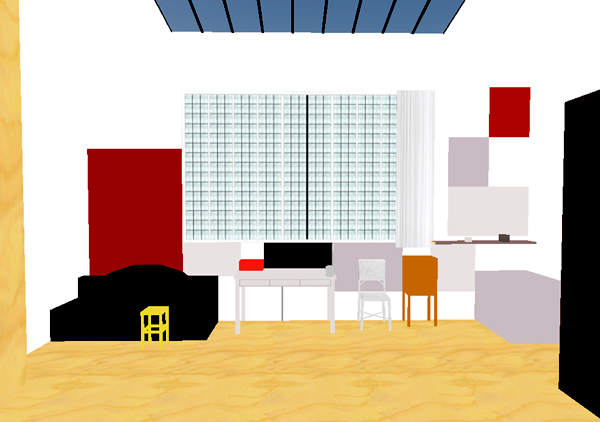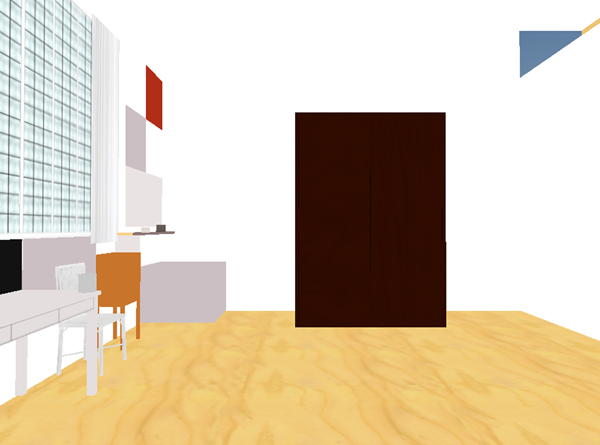Data Interpretation: Methods and Tools
Paradata in Art-historical Research. A Visualization of Piet Mondrian’s Studio at 5 rue de Coulmiers
by Ryan Egel-Andrews
ABSTRACT
‘Three-dimensional’ is not a term commonly associated with Piet Mondrian’s aesthetic concerns. The abstract works of his mature period which begin to emerge after his return to Paris in 1919 are uncompromisingly flat, volume-less paintings which proclaim as their purpose the destruction of objectivity in favour of abstract line and colour relationships. However, the second Paris period is also characterized by an increasing interest in architectural space, both theoretically and practically, in which Mondrian devoted considerable attention to developing Neo-Plasticism beyond the edge of his canvas. To speak of Mondrian from 1919 onwards as a painter of two-dimensional, abstract canvases is to deny a complete understanding of his artistic ambition.
On his return to Paris in 1919 Piet Mondrian began to put into practice ideas he had been developing on the application of Neo-Plasticism in architecture. His studios were spaces where he made the first practical steps in this direction, organizing them in accordance with his artistic principles. This dissertation attempts to recreate a 3D model of the studio at 5 rue de Coulmiers using fragmentary documentary evidence. The model is then used to draw conclusions regarding the challenges Mondrian faced in the application of Neo-Plasticism in space with emphasis on visualization as a process that generates art historical arguments.
A video of the model of Mondrian’s studio at 5 rue Coulmiers, placed on the King’s College London Digital Humanities region of Second Life, is available on YouTube. The documentation is on the project wiki.
The order of illustrations below follows the book (please note the distinction between figures and plates).

Plate 10.1 Visualization of Piet Mondrian’s studio at 5 rue de Coulmiers, Paris.
South wall view with and without easel © Ryan Egel-Andrews, 2009.

Figure 10.1 Visualization of Piet Mondrian’s studio at 5 rue de Coulmiers, Paris. Detail of south wall
© Ryan Egel-Andrews, 2009.

Figure 10.2 Visualization of Piet Mondrian’s studio at 5 rue de Coulmiers, Paris. North wall
© Ryan Egel-Andrews, 2009.



Pingback: DEN | digitaal.allemaal. » Blog Archive » Networked Humanities: Art History in the Web
Pingback: Paradata and Transparency in Virtual Heritage | PARADATA
Hello, I’m just finishing a book on Mondrian’s time in London (September 1938 – September 1940). I don’t suppose you have any ideas about his studio at 61 Parkhill Road?
Hi Charles
Any news on when the book will be published? I’ve been looking out for it since it was mentioned in a December 2010 article.
Regards, Nick Blackburn
Hello, Nick – Sorry for the slow reply, but Ryan Andrews has only just pointed your message out to me. As to the book … I’ve been waiting for the Mondrian Archive in The Hague to finish digitising some new material, but frankly I think I’m going to have to give up and just hand in my manuscript to the publishers as is. So it should be out in February. Any hot tips?
Good wishes, charles
Thanks Charles
If you know the secret of getting answers from the Mondrian, Holtzman, or van Doesburg archives, please pass it on – I have never managed a peep from any of them.
Let me know if you need a proofread by an interested amateur, else I’ll just have to wait until February.
Cheers, Nick
Ryan
My apologies for using your page as a postbox.
Congratulations on your work which is an important, original and entertaining contribution to Mondrian research.
Cheers, Nick
No problem – glad we’ve all come together.
Thanks – The book that is subject of this blog is due out probably around the same time as Charles’s I believe. You might need to head off to a library to read it though!
Pingback: Los estudios de Piet Mondrian / Reconstrucción del estudio 26 Rue Depart | Aryse.org
Pingback: Los estudios de Piet Mondrian / Reconstrucción del estudio 26 Rue Depart